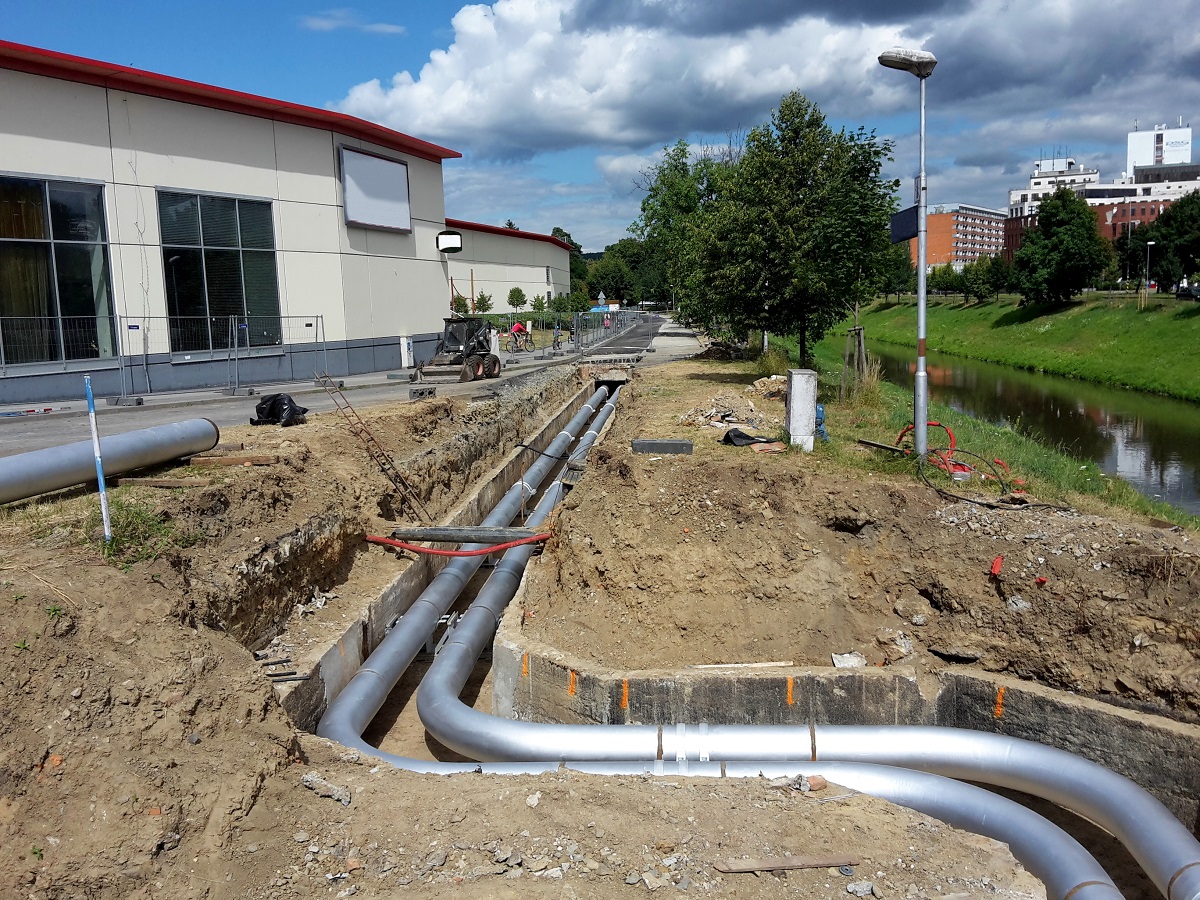Heat networks use a central source of generated heat which is then distributed via pipework either to a small scale communal (multiple users in the one building) system or to a larger district heating network (DHN).
Most existing heat networks use fossil fuels as the heat sources but low carbon sources of heat which can be used include geothermal (both deep and shallow ground source heat pumps), waste heat (from industrial processes) and biomass.
Currently, the main driver is the potential for DHNs to provide significant carbon savings compared to conventional heating systems. Northern Ireland has a limited number of heat networks, believed to be about 120 (mainly communal systems.)
What is a heat network?
When talking about heat networks we distinguish between district heating and communal heating.
District heating
These networks vary in size and length, carrying heat from just a few hundred metres between homes and flats, to several kilometres and can even cover an entire city. This avoids the need for individual boilers or electric heaters in every building.
Communal heating
Heat is supplied within a single building to multiple occupants, for example, heat supply in a block of flats. (Source: Energy Saving Trust website).
Both types distribute thermal energy in the form of steam, hot water or chilled liquids to multiple properties for the use of heating, cooling or hot water. Often, combined with fabric improvements in existing buildings to reduce heat loss, the use of water or ground source heat pumps can then raise the flow temperature further to generate appropriate heat for both residential and commercial buildings.
Benefits of heat networks
There are many benefits of heat networks compared to supplying heat at an individual building level. These include:
- offering significant carbon savings compared to conventional heating systems
- their ability to supply heat using local resources which can be scaled up, thus replicating the success of renewable electricity generation which also uses local energy sources
- that the source of heat can be from indigenous renewable sources including water, industry surplus heat, geothermal (shallow or deep), solar, biomass, biomethane and combined heat and power
- Indigenous renewables sources offer potential solutions to decarbonise existing heat networks, as the primary energy source can evolve over time
- that they can also operate to provide cooling to buildings, particularly in the summer months.

What the NI Energy Strategy says
The Energy Strategy: The Path to Net Zero is clear that heat networks are an important consideration in the decarbonisation of heat. The strategy states:
“To develop opportunities for heat networks we will assess potential solutions to decarbonise existing heat networks”.
and that:
“We will take forward heat network trials and demonstrators, using a range of energy sources including geothermal energy and, where feasible, waste heat.”
Heat networks can form an important part of DfE’s plan to reduce carbon emissions, so encouraging lower carbon emissions from heating.
Progress so far
NI input to second National Comprehensive Assessment of the potential for Efficient Heating and Cooling.
In September 2021 a study was published which identified the opportunity areas for district heating networks in the UK. Led by the Department for Energy Security and Net Zero, then known as BEIS, this is available gov.uk website.
Legislation/regulation
Currently heat networks are regulated by the Heat Network (Metering and Billing) Regulations which require fair and transparent billing of customers on heat networks, through accurate billing requirements and heat network suppliers to notify the Office for Product Safety and Standards of their heat networks’ attributes. Further information on the requirement is at Regulations: heat networks (metering and billing) - gov.uk website
In early 2022, the department issued a consultation Heat Networks Market Framework to consider the public’s views. The aim of the policy is to promote and support the development of low-carbon heat networks in a regulatory framework that protects consumers and ensures fair pricing. The policy is incorporated into the Energy Bill and it will effectively:
- introduce new protections for the users of heat networks to ensure the heat they use is fairly priced
- ensure users have a continued supply if their provider goes out of business and a route of appeal/complaint if anything goes wrong
- provide consumer protections for the people who get their heat from a shared heat network to ensure they are afforded similar protections to people who buy electricity or gas to heat their homes
- provide the Utility Regulator for Northern Ireland oversight and regulatory powers across quality of service, provision of information and pricing arrangements for all domestic heat network consumers.
Following this consultation, there has been ongoing liaison between DfE officials and DESNZ as policy has been developed by the UK government to apply on a UK wide basis, including taking account of the NI input resulting from the consultation.
DfE will engage further with stakeholders as policy is developed and refined ahead of potential implementation of the regulatory framework.
Case studies
The Energy Strategy Action Plan 2022 report references ground source heat pumps providing communal space heating and hot water for social housing providers and a geothermal project on a university campus to provide heating and cooling across several buildings on the one site.
Looking to the future
DfE is proposing to establish a regulatory framework for heat networks which protects consumers, promotes technical standards, and drives forward the growth and decarbonisation of the heat networks market.
This is in line with the Energy Strategy: The Path to Net Zero Energy vision of net zero carbon energy and affordable energy.
